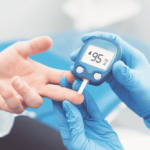By Jordan Messler, MD, SFHM, FACP
The implementation of Electronic Health Records (EHR) following the government mandate more than a decade ago hasn’t always been easy, but it can be a game-changer when it comes to real-time patient data management. While EHRs drastically simplify the access to patient-specific data, information overload and inefficient usage often leave providers struggling to transition insights into actionable data on a system-wide level. For many health systems, this began to change in 2020.
The pandemic put a tremendous strain on health systems, forcing them to move faster and more nimbly than ever before. One way these organizations responded to this call was by creating COVID-19 dashboards that organized vast amounts of EHR information across departments and sites to provide real-time views of infected patients, their location and treatment plans. These simplified data visualization systems armed providers and hospital officials with a significantly more in-depth understanding of critical factors, including confirmed positive patients, open hospital beds, the number of patients in intensive care units and even patients who needed ventilation support.
As hospitals continue to utilize these COVID-specific dashboards, they’re beginning to identify opportunities to leverage their value beyond the pandemic. Moving forward, health systems will expand these tools to optimize data and track various disease states such as heart failure, pneumonia, diabetes, and more. To do so, however, requires a clear goal, clean data and the proper technology.
Defining the Dashboard Goal
The medical and technology communities rallied together at the onset of the pandemic with one goal: prioritize care for COVID-19 patients. As such, dashboards were built to identify and address critical factors such as case count, hospital capacity and ventilator availability.
Moving into the new year, health systems need to ensure they have a clear goal in mind when expanding patient dashboards for various disease states. Take diabetes and glycemic management, for instance. Regardless of a pre-existing diabetes diagnosis, high blood sugar during hospital stays has been linked to worse outcomes in many disease states, from COVID-19 to sepsis, heart failure and kidney disease. By creating a dashboard (or widget on a larger dashboard) that tracks patient hypo- and hyperglycemia rates, time to target blood glucose range and glycemic trends, providers can analyze early indicators on which patients need adjusted insulin doses or other treatments to help enhance care. Studies have proven that improving glycemic management can reduce mortality rates and shorten hospital stays by more than three days, so identifying at-risk patients in real-time is a massive step toward improving care.
The problem, though, is that these dashboards are as only good as the data.
The Data Dilemma
In an attempt to generate visualization tools during the pandemic, many health systems realized they did not have optimized data sets. For example, some realized they were not tracking certain critical factors and lacked standardized definitions between facilities and departments – such as what constitutes an open bed. While the urgency of the pandemic led to quicker resolutions in discrepancies, it also illuminated the data dilemma in the healthcare field.
Clean and consistent data will be instrumental in developing real-time dashboards in 2021 and beyond. Keeping with the same hyperglycemia example, some hospitals currently track daily glycemic variance while others report the duration of a patient’s stay. A slight variation at the local hospital level can create unreliable and inconsistent data across an entire health system, severely impacting the dashboard’s validity. Fortunately, there is technology, like continuous glucose monitors that received emergency authorization from the FDA for hospital use during the pandemic, that can help increase reliability while feeding dashboards with important information.
Technology to Improve Data Flow
The pandemic proved that when a clear focus is paired with access to the right technology, clean EHR data and analytics, IT teams and hospital officials can create valuable visualization systems at a rapid pace.
As health systems move into 2021, they should consider how they used dashboards during the pandemic and how they can extend the concept to create efficiencies in other areas of care. This might require an audit of existing tools that track specific, standardized data points. Optimizing the data a health system already has at its disposal – or identifying where gaps in data exist – will make this a valuable exercise. For instance, eGMS can integrate seamlessly with EHR systems and other hospital technology to provide valuable glycemic information that feeds dashboards and drives deeper data insights. These types of tools also have the power to drive consistency around data collection, ensuring entire health systems are unified on the type of information they’re collecting.
In 2020, health systems built specific COVID-19 dashboards out of necessity. In 2021, these same hospitals will realize how they can optimize, expand and apply these powerful tools to track significant disease states across departments and hospital locations, helping improve access to actionable information and the quality of patient care.
About Jordan Messler
Jordan Messler, MD, SFHM, FACP is the Executive Director, Clinical Practice with Glytec. He trained in internal medicine at Emory University in Atlanta, and subsequently served as an academic hospitalist at Emory University for several years after residency. He is the former medical director for the Morton Plant Hospitalist group in Clearwater, Florida (serving BayCare Health), where he continues to work as a hospitalist. He is the current physician editor for the Society of Hospital Medicine’s (SHM) blog, The Hospital Leader. In addition, he previously chaired SHM’s Quality and Patient Safety Committee and has been active in several of their national mentoring programs, including Project BOOST and Glycemic Control. He has talked at national conferences on a variety of topics such as teamwork in the hospital, quality and patient safety, the history of hospitals and mentoring quality improvement projects.
The Editorial Team at Healthcare Business Today is made up of skilled healthcare writers and experts, led by our managing editor, Daniel Casciato, who has over 25 years of experience in healthcare writing. Since 1998, we have produced compelling and informative content for numerous publications, establishing ourselves as a trusted resource for health and wellness information. We offer readers access to fresh health, medicine, science, and technology developments and the latest in patient news, emphasizing how these developments affect our lives.









